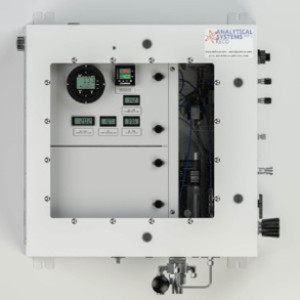Oil in Water Analyzer
The ability to analytically quantify and measure oil in water is greatly enhanced with the Sample Transfer Stripper (exclusive ASI Membrane Technologies) and the solid state sensor offered by Analytical Systems Keco.
Our oil in water analyzer (also called an oil in water monitor) is very easy to maintain and does not require routine calibrations in the field. It is field-proven to maintain a typical 99% up-time.
The Model 204 analyzer accurately measures total hydrocarbons including aliphatic and aromatic hydrocarbons. Alternative oil in water monitors utilizing the UV Fluorescence methods do not have the ability to measure aliphatic compounds.
Furthermore, the UV Fluorescence method suffers from cross-sensitivity with components in the water not intended to be measured, such as debris and contamination. This gives false high readings and false high alarms. The on-line analysis offered by the Model 204 is economically superior to inaccurate laboratory analyzers where unstable grab samples result in oil deterioration that produce analytical errors.
The liquid sample continuously flows into the analyzer and into the heated Sample Transfer Stripper unit which effectively strips the hydrocarbons from the oil in the water based in part on Henry’s Law. The carrier air then sweeps the hydrocarbons to the metal-oxide sensor for quantitative analysis in ppb or ppm levels. The advanced transmitter electronics quantifies and displays the values on the back-lit LCD display, 4-20mA output loop and can communicates via RS-485 Modbus. Remote and Web based monitoring and control of the analyzer is available. The optional ‘True’ Liquid Validation System by PermTube is utilized to verify proper operation of the entire analyzer – not just the sensor – with just a flip of a switch or remote activation.
This onboard functional validation option introduces hydrocarbons into the analyzer flow path via Permeation Tube. A “bump” up in analyzer’s reading will occur, conveniently verifying proper operation of analyzer.
Applications include the analysis of oil in water for cooling towers, heat exchangers, holding ponds, run off water, waste water, produced water and more.
Read some of our client success cases for this analyzer.
• Continuous on-line analysis
• No routine calibrations required
• 30+ Years Experience
• Field-proven reliability
• Typical 99% uptime
• Measures single digit PPBw & high PPMw ranges
• True Liquid Validation by PermTube
• Measurements include aromatic & aliphatic compounds
• TCEQ “Best Available Control Technology”
• Hazardous area classification: Division 1 and 2, Zone 1 and 2, ATEX and IECEx certificates available
• Preferred Vendor by Shell & Saudi Aramco
Bilge water discharge monitoring
The International Maritime Organization (IMO) and the U.S. Coast Guard (USCG) requires all ships over 400 gross tons to monitor bilge water discharges and are limited by 15 ppm. The Canadian Coast Guard limits discharge concentration at 5 ppm.
Oil in Waste water
Where the dissolved oil or hydrocarbon content could be PPBw, PPMw, or at saturation levels, Model 204 Oil in Water Analyzer easily provides continuous measurement online.
Oil in produced water
The Model 204 Oil in Water Monitor can continuously monitor the discharge of produced water as required by the Environmental Protection Agency (EPA) and other requirements. The EPA requires that produced water discharge must contain a concentration of less than 29 ppm oil and less than 42 ppm grease for a 30 day average and daily maximum.
Oil in Cooling Water and Holding Ponds
Equipment leaks, spills, and drainage run-offs can cause build-up of hydrocarbon in the water. The Model 204 can give a continuous online indication of the volatile organic carbon (VOC) / oil contained in these waters.
Fuels in Storm Runoff Water
It is required by the U.S. EPA that all storm water runoff be monitored. The Model 204 can continuously detect fuel in water at a concentration 1 ppm or better, including as dissolved hydrocarbons.
Phenol in Water
The Model 204 can continuously monitor the cooling water to detect a leak and prevent a discharge violation.
Hydroelectric dam sumps
Drain systems for fuel oil storage tank area
Includes hydro-carbon storage facilities.
Ground water recovery sites
Includes fuel storage and transformer sites.
Boiler condensate and power plant cooling water reclaiming systems
Including integral oil coolers.
Intake monitoring for Desalination plants
Water discharge in municipal water treatment systems
Oily water or grease discharges in excess of 15 parts per million(ppm) is not allowed or surcharged in most municipal water systems.
Engine cooling water
Engine damage can be caused by oil in engine cooling water.
Effluent monitoring
After an oil-water separator.






